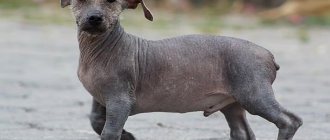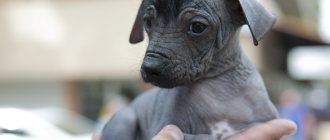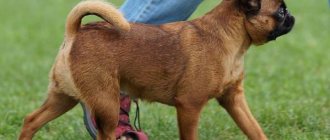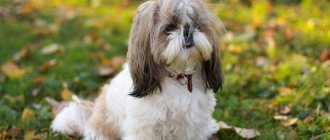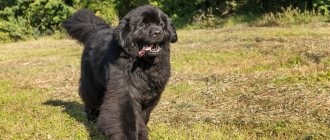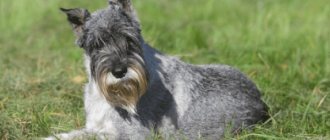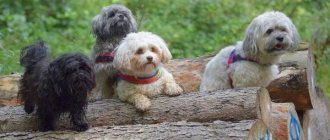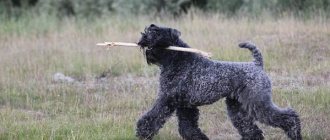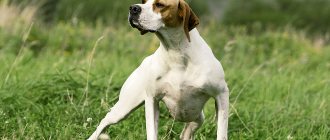Features and Descriptions
The world learned about the Xoloitzcuintle dog thanks to the Mexicans. Experts believe that hairless, that is, hairless dogs have always been owned by residents of not only warm but also cold countries. This exotic pet was memorable not only for its appearance. There is something magical and enchanting about it. Usually, people call it charm or charisma. But can an animal have any of these qualities? Xoloitzcuintle - yes.
The surprising thing is that this dog formed independently, naturally. That is, the person did not put any effort into its selection. The breed has gone through all the stages of natural selection and today we know it almost in its original form.
The Xoloitzcuintle is also called the Mexican Hairless Dog.
Interesting ! Dog breeding experts claim that their lack of hair is nothing more than a genetic mutation. However, it does not affect their health in any way.
Representatives of this breed are good companions. They are made specifically for friendship. But among them there are excellent guards. Of course, it is difficult to classify a naked small dog as a professional four-legged guard. But, he shows signs of anger if he senses a threat. His behavior in everyday life is often unpredictable.
It is worth noting that most breeders highly rate this breed. In their opinion, she has the right to belong to status. Nature has endowed its representatives with a lot of advantages:
- Calm character.
- Adequate reaction to strangers.
- Tolerant attitude towards other pets of the owner.
- No predisposition to dangerous diseases, good health.
- Quickly gets used to the owner and all members of his family.
- Friendly attitude towards guests.
- Positive life attitude.
Xoloitzcuintle dogs have a sensitive nature
Breed standard and species
Three types of Xoloitzcuintle breed :
- Standard.
- Dwarf.
- Toy.
Each of them differs in weight and height at the withers. So the tallest representative of the breed reaches 60 cm in height, the average one – 43 cm, and the shortest – 22-25 cm. Dogs from the standard type are the most massive, weighing up to 18 kg, dwarf dogs – up to 11 kg and toy dogs – up to 5 kg.
Representatives of the breed are also classified based on the presence of fur. Most of them are completely hairless, some have guard hairs on their faces, and only a few are born with fur. They are no different in appearance and habits.
Let's take a closer look at the breed standard. The Xoloitzcuintle in the photo looks like a Sphynx cat. He is just as gentle, sophisticated, and most importantly - completely devoid of fur.
Interesting ! The body of females of this breed is longer than that of males. This feature was given to them by nature to make feeding the puppies easier.
The dog's back is straight and elongated. The neck is muscular and has a curve. When a baby Xoloitzcuintle is born, this part of its body is covered with large folds of skin. Over time, the skin on their neck smooths out. If an adult dog of a given breed has them, he is considered not a purebred.
Despite the lack of hunting skills, it has the strongest knee joints on its hind legs, allowing it to push off the ground well in order to make a dash and run quickly. The legs are placed symmetrically. If an individual is born with a dewclaw, it must be removed.
Otherwise, she will not be able to take part in the dog competition. The tail of the animal is very thin, bare, but slightly thickened at the base. It is in a lowered state. The animal rarely wags at it, even if it is in a good mood.
Important ! If a dog's tail is tucked to its stomach, this is a clear sign of fear. Have pity on the animal so that it feels protected.
The body type of the Xoloitzcuintle closely resembles the classic body of a hunting hound. He has the same sunken belly, thin chest and high paws. But the hunting instinct of such an animal is underdeveloped.
The dog's head is small, but harmonizes well with its long, thin neck. The muscles on the muzzle are well developed. The bridge of the nose is straight. The lips are dry, pressed against the teeth. No drooling from the mouth. Malocclusion is the main reason a dog is disqualified from competition.
Some individuals do not have molars from birth. The standard allows for such deviation. The color of the nose can be black, pink or brown (depending on skin tone). The dog's eyes are small, like beads.
The iris can be colored gray or brown. Dark eye shades are more appreciated. The animal's ears are erect and large. They can change position, such as turning forward, if it is interested in something.
Important ! It is worth noting that the population of such dogs in the world is small. There are only a few high-breed representatives among them.
Even though the Xoloitzcuintle is a hairless breed (most of them), it does have some short fur on some areas of its body, such as its face, paws, or tail. Individuals with a small tuft on the top of their heads look a little funny, but cute. According to the standard, the coat of such a dog should be extremely hard.
“Puff coats” (dogs whose body is completely covered with fur) should not be bred. As for the skin color of these animals, it can be pinkish, brown, brown or sandy. The standard also allows for stains.
Character
These unusual-looking animals communicate well with people, but not with their own kind. You should not expect that a small bald dog prone to dominant behavior will form a strong friendship with, for example, a Pekingese or a German Shepherd.
Some peoples consider the Xoloitzcuintle to be a breed that can cure illness.
Important ! If dogs already live in your apartment, introduce them only to the Xoloitzcuintle puppy . An adult representative of the breed will never get along with them due to his selfish nature.
These are very loyal animals who are kind to their household. They easily and quickly make contact and become attached with their souls to every person who speaks kindly to them. They tend to be friendly, caring and even sympathetic. They are great companions!
As for security skills, the Xoloitzcuintli undoubtedly has them. A dog may attack a suspicious stranger, especially if he raises his voice at his owner or tries to hit him. In the presence of such a dog, none of the household members will suffer.
It can severely bite through a person’s skin, cause him physical pain and seriously frighten him. However, she is not prone to causeless anger. Strives to resolve conflicts peacefully. He may leave if he is offended. But the feeling of physical superiority over the offender will certainly become a reason for her to attack him.
They get along well with other domestic animals only if they were socialized with them in early childhood. They tend to be independent and moderately selfish. They do not require frequent attention to their person. If the owner of the house, they will probably accompany you, but in his absence they will not get bored. Such a dog will definitely find something to do and have a good time.
These are quite temperamental and calm animals, which specialists use in psychotherapy. They have nice skin - this is one of the main reasons that pushes people to interact with them. They get along very well with children. They are never denied attention.
Features of the breed and character of the Toller
Toller is a dog breed considered to be the youngest, because it was officially recognized relatively recently, after the end of the Second World War, first in Canada, and some time later in European countries.
The chronicle of the origin of these cute, energetic and hardworking dogs, endowed with the most multifaceted talents, is full of secrets. All the details of their prehistory have not been clarified with certainty, just as the homeland of the tollers , the place on earth where their ancestors came from, is not clearly known.
There is information that early representatives of this breed back in the 17th century were used to attract ducks and other birds on the peninsula, where the province was located, later called by the British: Nova Scotia.
It is believed that the ancestors of the dogs could have been retrievers and collies, possibly hunting dogs of Danish origin, brought from the Old World to Canada, although such facts have not been conclusively confirmed.
Toller is an unusual dog. These four-legged animals have a special and amazing gift when hunting for feathered game: to lure it, playfully fooling around and luring the hunter into the line of fire.
And after firing a gun, they bring the wounded or killed bird to the owner, taking it out of cold water or dense thickets. For this almost mystical ability, the dogs were nicknamed “duck whisperers”, and for distracting game, intensely bright shades of fur - fire dogs.
Despite the excellent qualities, undoubted efficiency and perseverance, there were problems with the popularization of Tollers or Nova Scotia Retrievers (as the more complete name sounds).
At the international level, the breed was recognized only in 1987, at which time its standards were adopted and clarified. But today dogs are in great demand in many European countries and are especially loved in Scandinavia.
Representatives of the breed are classified by dog handlers as hunting gun dogs, but they perform excellently not only for their intended purpose. They have proven themselves in sports competitions, showing impressive speed and accuracy when passing complex and intricate obstacle courses, as well as when certifying in various types of training and agility.
Regardless of his state of mind and weather, the Nova Scotia Toller is ready to work without rest, even half asleep, reacting to his owner’s commands, catching his smallest gestures with an attentive gaze. Such dogs most of all adore the “fetch” command, because offering game is inherent in their very nature.
In the photo there is a dog of the Toller breed
Dogs are extremely smart, but when training they require a creative approach and a variety of tasks, since the monotonous repetition of various commands seems boring to them.
At work they are attentive and tireless, in everyday life they are dexterous, impressing others with a very decisive appearance. Their wild hunting temperament is expressed in a constant thirst for activity.
The dogs languish without movement or use, and when they get to work, having a serious attitude, they take a stance characteristic of the Toller breed , fixing their gaze and stretching their head forward at the level of their back. Having a relaxed and bored appearance when inactive, they are extremely graceful and energetic when moving when following commands and completing obstacle courses.
Dogs, as a rule, treat strangers with distrust and aloofness. When entering a family, they strive to choose one owner, respecting his domineering firmness and strong will.
Maintenance and care
This pet is ideal for apartment living. It does not require painstaking care, which is its advantage. Living in a cramped space does not frighten the Xoloitzcuintle at all. He is moderately active and does not require systematic sports activities, like, for example, the East European Shepherd.
Some owners prefer to teach this dog to relieve itself in a litter box, like a house cat. And this is absolutely normal practice! The animal is well adapted to apartment life, but providing it with comfort will not go amiss.
Take care of purchasing a soft sleeping place for him. You can also invite him to sleep next to you. Usually, these cute dogs themselves ask to be under the blanket with their owner, as they periodically freeze. The warmth of the human body warms them - hence the desire to sleep next to people. It is not recommended to deny your pet such a small thing.
A few basic tips for caring for a hairless dog:
- You should wash with shampoo 2 times a year - in winter and summer. It is important to exclude the possibility of drafts! The Xoloitzcuintle will get sick easily if they are present.
- The animal's face is washed with running water once a week.
- The ears are cleaned with a wet cotton swab or a clean rag. You can use cotton fabric.
- The claws are trimmed as they grow.
- Teeth are cleaned every day or every other day.
- The pads of the feet are washed in the sink.
The most important skincare rule is wiping the body. The skin of such a dog gets dirty very often, even if it lives in the house. This is due to the lack of undercoat and fur.
Important ! In winter and summer, you will have to take special care of your dog. When it’s cold, it needs to be insulated with overalls, and when it’s hot, it needs to be lubricated with cream with UV protection.
Nutrition
Unfortunately, Xoloitzcuintles very often suffer from allergies, especially to specific foods. For this reason, experts strongly recommend that owners of such pets not feed them food from their table. At any moment they may experience an adverse reaction in the form of vomiting, rash, etc.
Therefore, the best product for such an animal is dry food. It can be bought in an online store, a zoological salon, and even in a veterinary clinic. A good option is to first consult with the doctor who observed your animal.
Important ! You should not feed your Xoloitzcuintle puppy a grain feed mixture. You should also avoid products that contain dyes or food additives.
If an animal has dental problems, it is recommended to give it soft dry food. It is also commercially available. Feeding it with cereals, meat or berries is prohibited.
Your pet may develop a food allergy if they eat the following foods:
- Pasta.
- Dishes prepared with a lot of spices.
- Honey.
- Delicious baked goods.
- Canned meat.
Where is the best place to buy
It is necessary to purchase a puppy for breeding or exhibitions in good nurseries, clubs or from competent breeders with a good reputation. If you have never made such purchases before, you should familiarize yourself with all available information about the seller (its representatives).
Serious nurseries publish information on the sale of puppies on their websites, provide an announcement of the litter, and a description of the parents. When buying a puppy for ambitious purposes, you must fully familiarize yourself with all the documentation: vaccinations, pedigree, awards, medical records of the parents and other information.
Reproduction and lifespan
These are not easy dogs, and there are a lot of requirements for their breed. Experienced breeders always organize their mating according to the following rules:
- Only mature females and males (over 2 years old) are selected.
- Excluded from breeding are older individuals (those older than 6-7 years).
- A place is being prepared for mating of a female with a male in his house.
- Waiting for the 3rd day of the bitch's heat.
- Do not interfere with the introduction of dogs.
- If it is unsuccessful, their meeting is rescheduled.
Xoloitzcuintle bitches are good and caring mothers. They extremely rarely refuse to feed their brood. They may do this due to the presence of a foreign odor on their body. Therefore, we strongly advise against holding newborn puppies on the first day.
If the bitch refuses to feed her puppies, you will have to help them gain weight. Use her expressed milk poured into a baby bottle with a nipple. Don't let babies overfeed! They must feed on mother's milk for at least 1 month, the optimal period is 2-3 months. These dogs live for about 14 years.
In a Xoloitzcuintle litter, one out of five puppies is always born with fur.
How to choose the right one so as not to make a mistake in price
At the nursery or breeder, carefully examine the baby. In addition to the general requirements (cleanliness, activity, cheerfulness of the puppy, good living conditions), check the puppy’s card (if it is under three months old) with information about the parents and vaccinations. Purebred dogs older than three months must have a veterinary passport.
Important! Study the pedigree, talk to the puppy’s parents, look at their behavior, habits, and appearance. Check the tummy stamp number with the registration number shown on his passport or card. Check for vaccinations (8th, 12th week).
Representatives of a nursery or club, or a reputable breeder will definitely recommend a puppy to you according to your desires and capabilities. Take with you for consultation a specialist who is well versed in the breed; his knowledge will help you not to make a mistake. The main thing is that the puppy corresponds to its purpose.
The appearance of the parents is not inherited by the baby , so to purchase a bear-type orange, it is better to buy a puppy that is 4-5 months old, when the shape of the muzzle is already visible.
We hope that the following tips and recommendations will help you choose the “right” puppy. What do you think about pricing for the Pomeranian breed? Do you like this dog?
Price
There are very few Xoloitzcuintles in Russia. There is only 1 nursery in the capital where they are bred and sold. By making a purchase in this place, you get a guarantee of purchasing a hairless Mexican dog that fully complies with the standard of its breed. But buying it second hand is not worth it.
The price of a xoloitzcuintle in 2022 is 80 thousand rubles. There are a lot of advertisements on the Internet for the sale of non-purebred representatives of this breed, which are sold much cheaper, from 10 to 30 thousand rubles. But, most of the animals offered there have nothing in common with the Mexican Hairless.
How much does a puppy cost?
How much does a Pomeranian puppy cost:
- A dog without a pedigree, but looks like an Pomeranian - from 300 to 500 US dollars.
- Breeding marriage from breeders and nurseries – 500-700 US dollars.
- Brad class baby – $700-1000 and above.
- Show puppies – more than $1000.
How much does a bear-type Pomeranian cost:
- girls – from 1000 US dollars and above;
- boys - from 700 dollars.
How much does a Pomeranian dwarf Spitz cost (mini):
- girls – from $1200;
- boys - from $700-800.
Note! In Russia, the price for a puppy is from 20,000 rubles to 70,000, in Ukraine - from 15,000 hryvnia to 45,000 hryvnia, in Belarus from 500 Belarusian rubles to 2,000, in the USA from 350 dollars to 9-10 thousand.
Education and socialization
There are several reasons confirming the good training ability of such a dog. Firstly, nature has blessed him with an excellent memory, and secondly, he is very smart. However, the animal is quite capricious and strives, at all costs, to maintain its independence.
A puppy of this breed can be taught obedience, but this requires endurance and perseverance from the owner. Observe the animal as it settles into your home. You should not allow him to climb the wires, sniff the food on the table, or behave too intrusively. A dog prone to dominance must be taught discipline from an early age. Otherwise, she will grow up suspicious and distrustful.
Practice shows that almost no one has problems raising a Mexican naked. She is outgoing and friendly, loves human company and rarely bullies animals. But, if conflicts with her participation still periodically break out, measures will have to be taken.
Follow the development of events in the dog pack and identify the instigator. If your bald friend is your friend, grab him by the withers and then turn him over onto his back. Let other dogs sniff his tail.
This procedure is not sadistic at all, but absolutely humane. Thus, the status of the animal in the group is reduced to an acceptable limit. After this, it becomes less cocky, but more inclined to obey.
Training a Xoloitzcuintle requires kindness and moderate severity.
If your pet barks for no reason, it's bad. He probably does this out of boredom. Then he should just take some time, for example, go for a walk together or go play in nature. New experiences are extremely important for the socialization of such a dog. He will grow up closed and limited if his horizons are not systematically expanded.
An important rule is that a domestic dog should come at the first call of its owner. If this does not happen, she is clearly trying to dominate, that is, she does not respect you. How to teach her obedience and respect?
It is enough to spend at least 4 hours a day together, educate and always reward for efforts and good behavior. Remember that in raising a four-legged pet, 2 methods should be used: carrot and stick.
Cost of an adult dog
The price for an adult Pomeranian is much lower than for a puppy. Take into account that in this case you are purchasing a dog that has already been formed and raised by another person. It is very difficult to change the character of a pet to suit yourself; this is rarely possible with an adult dog without traumatizing its psyche and behavior.
Take a closer look at the orange, if it suits your character and behavior, choose it. That is why the price for an adult is several times lower than for a puppy (from 2 to 5 times).
Possible diseases and methods of treating them
The most dangerous illness for Xoloitzcuintles is food allergies. Unfortunately, almost all representatives of the breed are prone to it. If this disease is present, the animal experiences the following symptoms:
- Itching.
- Redness of the skin.
- Nausea, possibly vomiting.
- Weakness.
- Increased tear production.
- Difficulty breathing, swelling of the nasopharynx.
Vaccinations given to your dog as a puppy will help reduce the risk of allergies. But, in order to definitely prevent its occurrence, do not give your pet food from the table, especially heat-treated food.
Since this Mexican breed has no fur, they are susceptible to dermatitis, a common skin condition. As it develops, the animal experiences severe itching.
The integrity of its skin is also partially compromised. The disease is provoked by poor diet and lack of hygiene procedures. Dermatitis in dogs, like food allergies, can only be treated by a veterinarian.
Well, the last thing that should be highlighted is limb injuries. The Xoloitzcuintle gets them often, especially during active games. Therefore, to minimize the risk of injury, do not throw objects high and far to your dog so that he does not have to quickly chase them, much less push off the ground to jump.
